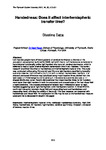Handedness: Does it affect interhemispheric transfer?
| dc.contributor.author | Datta, D. | |
| dc.date.accessioned | 2021-12-24T18:02:54Z | |
| dc.date.available | 2021-12-24T18:02:54Z | |
| dc.date.issued | 2021 | |
| dc.identifier.citation |
Datta, D. (2021) 'Handedness: Does it affect interhemispheric transfer?', The Plymouth Student Scientist, 14(2), pp. 513-531. | en_US |
| dc.identifier.uri | http://hdl.handle.net/10026.1/18513 | |
| dc.description.abstract |
Left- handed people have different patterns of cerebral dominance to the rest of the population, as explained by Annett’s (1996) right shift theory. Left handers are considered to have bilateral functionality unlike right handers who have left cerebral dominance, which is believed to lead to faster interhemispheric transmission time in left- handers. The current research examined the effect of handedness on interhemispheric transfer time. The study was conducted online using fifty-one left and fifty-one right handers classified by laterality quotients obtained from Oldfield’s (1971) 12 item Edinburgh Handedness Inventory. The crossed uncrossed difference was calculated using mean reaction times yielded from the task based on Poffenberger’s (1912) paradigm. The laterality quotients produced a “J” shaped distribution curve. Results demonstrated that mean reaction times for left handers were faster than right handers in both the uncrossed and crossed state of the four visual field x hand conditions. The crossed uncrossed difference was 1 millisecond faster for right handers suggesting faster right hemisphere to left hemisphere transfer. A mixed ANOVA confirmed interaction between visual field and responding hand and handedness and responding hand, affirming the validity of the study. This was however, not observed with handedness and visual field. An explanation for this may be due to the handedness measure used and this is discussed in detail in this paper. | en_US |
| dc.language.iso | en | en_US |
| dc.publisher | University of Plymouth | en_US |
| dc.rights | Attribution 3.0 United States | * |
| dc.rights.uri | http://creativecommons.org/licenses/by/3.0/us/ | * |
| dc.subject | Interhemispheric Transfer Time | en_US |
| dc.subject | Edinburgh Handedness Inventory | en_US |
| dc.subject | Right Shift theory | en_US |
| dc.subject | handedness | en_US |
| dc.subject | left handers | en_US |
| dc.subject | right handers | en_US |
| dc.subject | cerebral asymmetry | en_US |
| dc.subject | Crossed Uncrossed difference | en_US |
| dc.subject | reaction times | en_US |
| dc.title | Handedness: Does it affect interhemispheric transfer? | en_US |
| dc.type | Article | en_US |
| plymouth.issue | 2 | |
| plymouth.volume | 14 | |
| plymouth.journal | The Plymouth Student Scientist |



